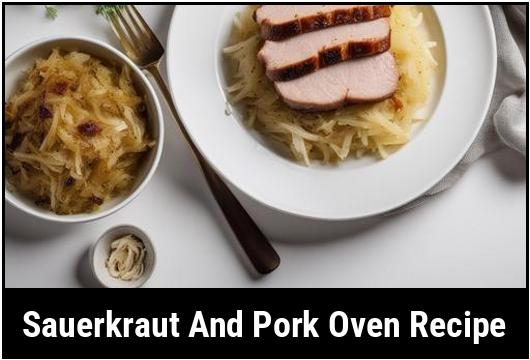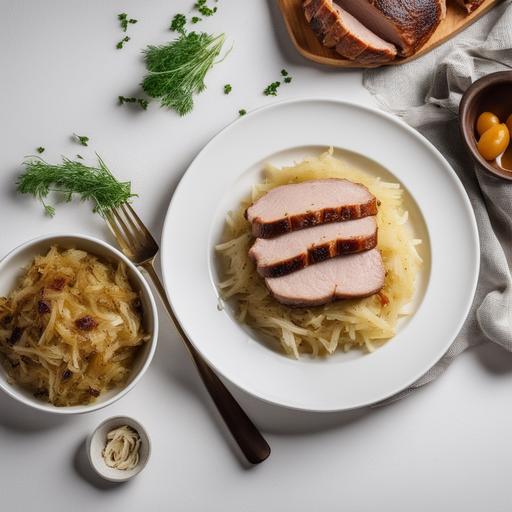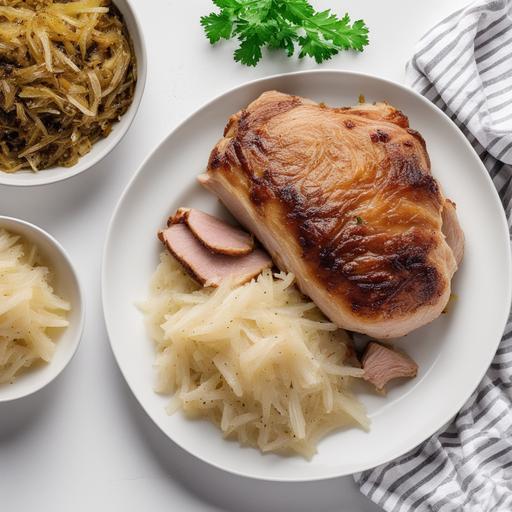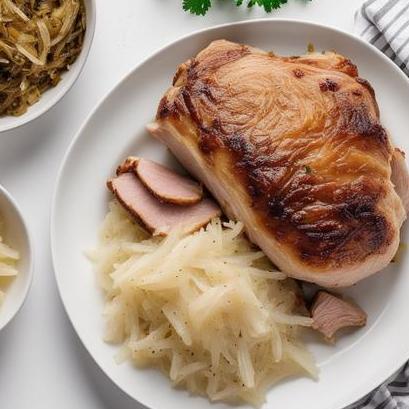
Sauerkraut And Pork Oven Recipe: A Match Made In Heaven
Sauerkraut and pork is a classic combination that has been enjoyed for centuries, particularly in Central and Eastern European cuisines. This hearty dish combines the tanginess of fermented cabbage with the richness of pork, resulting in a flavorful and comforting meal. While there are many ways to prepare sauerkraut and pork, cooking it in the oven is a popular method that yields tender meat and perfectly cooked sauerkraut. In this article, we will explore the food science behind cooking sauerkraut and pork in an oven, discuss the importance of choosing quality ingredients, and provide a detailed recipe for making this delicious dish at home.
Food Science Of Cooking Sauerkraut And Pork In An Oven
Cooking sauerkraut and pork in an oven involves a combination of dry and moist heat cooking methods. The oven provides dry heat, which helps to brown and caramelize the pork while also cooking it evenly. Additionally, the enclosed environment of the oven helps to trap moisture, ensuring that the pork stays tender and juicy throughout the cooking process.
Sauerkraut is a fermented cabbage that is rich in probiotics and has a tangy flavor profile. When cooked in the oven with pork, the sauerkraut absorbs the flavors of the meat and any seasonings or aromatics used in the recipe. The heat of the oven also helps to mellow out the sharpness of the sauerkraut, resulting in a well-balanced dish.
Choosing Ingredients
Choosing high-quality ingredients is essential for making the best sauerkraut and pork dish. When selecting pork, opt for cuts that are well-marbled and have a good amount of fat. This fat will help to keep the meat moist and tender during the cooking process. Pork shoulder or pork loin are both excellent choices for this recipe.
For the sauerkraut, look for varieties that are fermented naturally and contain live cultures. These live cultures not only add flavor to the dish but also provide health benefits. Avoid sauerkraut that has been pasteurized, as this process kills off the beneficial bacteria.
In addition to pork and sauerkraut, you will also need some aromatics and seasonings to enhance the flavor of the dish. Garlic, onion, caraway seeds, and black pepper are all classic additions to sauerkraut and pork dishes.
Preparing Ingredients

Before you begin cooking, it’s important to properly prepare your ingredients. Start by preheating your oven to the optimal temperature for cooking pork, typically around 325°F (163°C) for slow roasting. This low and slow cooking method helps to break down the connective tissues in the pork, resulting in a tender and succulent dish.
Next, prepare your pork by seasoning it generously with salt and pepper. You can also rub the pork with minced garlic and caraway seeds for added flavor. If using pork loin, consider tying it with kitchen twine to help it maintain its shape during cooking.
Prepare your aromatics by chopping onion and garlic finely. These will be sautéed in a skillet before adding them to the sauerkraut and pork.
Finally, drain the sauerkraut and rinse it under cold water to remove any excess saltiness. Squeeze out any excess moisture and set the sauerkraut aside.
Optimal Oven Cooking Temperature & Timing
Cooking sauerkraut and pork in the oven requires a low and slow approach to ensure tender and flavorful results. Preheat your oven to 325°F (163°C) and place the seasoned pork in a roasting pan or Dutch oven.
Add the chopped onion and garlic to a skillet and sauté until softened and fragrant. Transfer the sautéed aromatics to the roasting pan with the pork.
Spread the rinsed and drained sauerkraut evenly around the pork in the roasting pan. Add any additional seasonings or aromatics, such as caraway seeds or bay leaves, for extra flavor.
Cover the roasting pan tightly with aluminum foil or a lid to trap in moisture. Place the pan in the preheated oven and roast for 2 to 3 hours, or until the pork is fork-tender and the sauerkraut is soft and flavorful.
Sauerkraut And Pork Oven Recipe
Ingredients
- 3-4 pounds (1.4-1.8 kg) pork shoulder or pork loin
- 1 tablespoon salt
- 1 teaspoon black pepper
- 3 cloves garlic, minced
- 1 tablespoon caraway seeds
- 1 large onion, chopped
- 2 cups (480 ml) sauerkraut, drained and rinsed
- Optional: bay leaves, juniper berries
Instructions
- Preheat your oven to 325°F (163°C).
- Season the pork generously with salt and pepper, then rub with minced garlic and caraway seeds.
- In a skillet, sauté the chopped onion and garlic until softened and fragrant.
- Place the seasoned pork in a roasting pan or Dutch oven.
- Spread the sautéed aromatics evenly around the pork.
- Add the rinsed and drained sauerkraut to the roasting pan, along with any additional seasonings or aromatics.
- Cover the roasting pan tightly with aluminum foil or a lid.
- Roast in the preheated oven for 2 to 3 hours, or until the pork is fork-tender and the sauerkraut is soft and flavorful.
- Serve the sauerkraut and pork hot, garnished with fresh herbs if desired.
Sauerkraut and pork cooked in the oven is a delicious and comforting dish that is perfect for any occasion. By understanding the food science behind the cooking process and choosing high-quality ingredients, you can create a flavorful and tender meal that will delight your taste buds. Whether you’re cooking for a crowd or just craving some comfort food, this sauerkraut and pork oven recipe is sure to satisfy. Enjoy!
Doneness Checks

Sauerkraut and pork oven recipe is a timeless comfort food that hails from Eastern Europe, particularly Germany and Poland. It’s a dish that celebrates the simplicity of ingredients while delivering complex flavors. The key components of this dish are pork, usually in the form of pork chops or a pork roast, and sauerkraut, which is fermented cabbage.
The magic of this recipe lies in the slow cooking process in the oven, which allows the pork to become fork-tender and infused with the tangy, slightly sour flavors of the sauerkraut. The gentle heat of the oven ensures that the pork cooks evenly and retains its moisture, resulting in succulent meat that practically falls apart.
Ensuring that the pork is cooked to the right level of doneness is crucial for both safety and flavor. Here are some key indicators to check for doneness:
1. Internal Temperature
The most reliable way to check if the pork is done is by using a meat thermometer. Insert the thermometer into the thickest part of the pork, making sure not to touch any bones. The pork should reach an internal temperature of at least 145°F (63°C) for safe consumption. At this temperature, the pork will be juicy and slightly pink in the center.
2. Visual Cues
Visually inspecting the pork can also provide clues about its doneness. Fully cooked pork will have a golden brown exterior and the juices running from it will be clear. Additionally, if you’re cooking pork chops with bones, the meat near the bone should no longer be pink.
3. Texture
The texture of the pork can also indicate its doneness. Insert a fork into the meat and twist it slightly. If the pork is done, the fork should slide in easily, and the meat should offer little resistance. Overcooked pork will be dry and tough, while undercooked pork will be rubbery and chewy.
Undercooking
Undercooking pork can pose a risk of foodborne illness, particularly if the meat is not cooked to a safe internal temperature. Symptoms of undercooked pork consumption include nausea, vomiting, diarrhea, and stomach cramps. To avoid undercooking:
- Use a meat thermometer to ensure that the pork reaches an internal temperature of at least 145°F (63°C).
- Allow enough cooking time for the pork to cook through completely. Thicker cuts of pork will take longer to cook than thinner ones.
- If in doubt, it’s better to err on the side of caution and cook the pork for longer rather than risking undercooking it.
Overcooking
Overcooking pork can result in dry, tough meat that lacks flavor and juiciness. To prevent overcooking:
- Use a meat thermometer to monitor the internal temperature of the pork and remove it from the oven once it reaches 145°F (63°C).
- Avoid cooking the pork at high temperatures for an extended period, as this can cause it to dry out.
- Consider using a meat marinade or basting the pork with sauce during cooking to help keep it moist.
Troubleshooting

Even with the best intentions, issues can arise during the cooking process. Here are some common problems and how to troubleshoot them:
1. Dry Pork
If the pork turns out dry, it may have been overcooked. To salvage dry pork:
- Slice the pork thinly and serve it with extra sauce or gravy to add moisture.
- Consider shredding the pork and using it in sandwiches or wraps with flavorful condiments.
2. Too Much Liquid
If the dish ends up too watery, it may be due to excess liquid from the sauerkraut or other ingredients. To fix this:
- Use a slotted spoon to remove excess liquid from the dish before serving.
- Consider thickening the sauce with a cornstarch slurry or reducing it on the stovetop to concentrate the flavors.
3. Lack Of Flavor
If the dish lacks flavor, it may need additional seasoning or aromatics. Try:
- Adding more salt, pepper, or other seasonings to taste.
- Incorporating aromatic vegetables such as onions, garlic, or caraway seeds to enhance the flavor profile.
- Allowing the dish to simmer for longer to allow the flavors to develop.
Recipe Variations
The beauty of the sauerkraut and pork oven recipe lies in its versatility. Here are some variations to try:
1. Beer-Braised Pork And Sauerkraut
Replace some or all of the liquid in the recipe with beer for a richer, more complex flavor. The beer adds depth to the dish and pairs wonderfully with the tanginess of the sauerkraut.
2. Smoked Pork Shoulder With Sauerkraut
Use a smoked pork shoulder instead of fresh pork for a more intense smoky flavor. The smokiness of the meat complements the tangy sauerkraut beautifully, creating a dish that’s bursting with flavor.
3. Apple And Pork Casserole With Sauerkraut
Add sliced apples to the dish for a touch of sweetness that balances out the tanginess of the sauerkraut. The apples melt into the sauce, infusing it with their natural sweetness and adding a deliciously fruity flavor to the dish.
Sauerkraut and pork oven recipe is a comforting and satisfying dish that’s perfect for family dinners or special occasions. By following the tips and techniques outlined in this guide, you can create a delicious meal that’s sure to impress. Whether you stick to the classic recipe or experiment with variations, the combination of tender pork and tangy sauerkraut is sure to be a hit every time. So fire up your oven, gather your ingredients, and get ready to enjoy a taste of tradition with this timeless dish.
Flavour Enhancement Tips
Sauerkraut and pork oven recipe is a classic dish that combines the tangy flavor of fermented cabbage with the savory richness of pork. This hearty and comforting meal has been enjoyed for centuries in various forms across Europe, particularly in Germany, Poland, and other Eastern European countries. The process of slow cooking the pork alongside the sauerkraut allows the flavors to meld together, resulting in a dish that is both flavorful and satisfying.
Flavor is the cornerstone of any great dish, and when it comes to sauerkraut and pork, there are several ways to enhance its taste:
1. Choosing Quality Ingredients
Start with high-quality pork and sauerkraut. Look for fresh, well-marbled pork cuts such as pork shoulder or pork loin. Additionally, opt for sauerkraut that is fermented naturally without any preservatives or additives for the best flavor.
2. Seasoning
Season the pork generously with salt, pepper, and any other desired spices or herbs before cooking. Common herbs and spices that pair well with sauerkraut and pork include caraway seeds, juniper berries, thyme, and bay leaves.
3. Adding Sweetness
Balancing the tanginess of sauerkraut with a touch of sweetness can enhance the overall flavor profile of the dish. Consider adding ingredients like apples, onions, or brown sugar to provide a subtle sweetness to the dish.
Texture Enhancement Tips

Achieving the perfect texture is essential for a satisfying dining experience. Here’s how to ensure your sauerkraut and pork dish has the ideal texture:
1. Browning The Pork
Before placing the pork in the oven, sear it in a hot skillet to develop a golden-brown crust. This step adds depth of flavor and enhances the texture of the meat.
2. Draining The Sauerkraut
If the sauerkraut is too watery, it can result in a soggy dish. To prevent this, drain the sauerkraut well before adding it to the baking dish. You can also gently squeeze out any excess liquid from the sauerkraut to ensure a firmer texture.
3. Layering Ingredients
Layering the pork and sauerkraut in the baking dish allows the flavors to mingle while ensuring that each bite has a perfect balance of ingredients. Start by placing a layer of sauerkraut on the bottom of the dish, followed by the seared pork, and then another layer of sauerkraut on top.
Cooking At Different Temperatures
The cooking temperature plays a crucial role in achieving tender, juicy pork and flavorful sauerkraut. Here’s how to adjust the cooking temperature based on your preferences:
1. Low And Slow
Cooking the sauerkraut and pork at a low temperature (around 300°F or 150°C) for an extended period (2-3 hours) results in meltingly tender meat and well-developed flavors. This method allows the collagen in the pork to break down gradually, resulting in a juicy and succulent texture.
2. High Heat
Alternatively, cooking the dish at a higher temperature (375°F or 190°C) for a shorter period (1-2 hours) can yield a crispier exterior on the pork while still ensuring tender meat. This method is ideal for those who prefer a slightly caramelized crust on their pork.
Cooking Tips
Mastering the cooking process is key to achieving a perfectly cooked sauerkraut and pork dish. Here are some tips to ensure success:
1. Use A Dutch Oven Or Roasting Pan
A Dutch oven or roasting pan with a tight-fitting lid is ideal for cooking sauerkraut and pork in the oven. These heavy-bottomed pots distribute heat evenly, ensuring that the pork cooks uniformly and stays moist throughout the process.
2. Add Liquid
Adding a bit of liquid, such as chicken broth, white wine, or beer, to the baking dish helps prevent the pork from drying out and infuses the sauerkraut with additional flavor. Pour the liquid over the pork and sauerkraut before covering the dish and placing it in the oven.
3. Baste The Pork
To keep the pork moist and flavorful, baste it periodically with the juices from the bottom of the baking dish. This helps to lock in moisture and ensures that the meat stays tender and juicy.
Serving Suggestions
Once your sauerkraut and pork dish is cooked to perfection, it’s time to serve it up and enjoy! Here are some serving suggestions to complement the flavors of the dish:
1. Mashed Potatoes
Serve the sauerkraut and pork alongside creamy mashed potatoes for a comforting and satisfying meal. The creamy texture of the potatoes pairs beautifully with the tangy sauerkraut and savory pork.
2. Rye Bread
Slice up some crusty rye bread to soak up the flavorful juices from the sauerkraut and pork. The nutty flavor of the rye bread complements the earthy tones of the dish and adds a delightful crunch to each bite.
3. Mustard Or Horseradish
Offer mustard or horseradish on the side for those who enjoy a bit of heat and tanginess with their sauerkraut and pork. These condiments add a punch of flavor and can elevate the dish to new heights.
Conclusion
Sauerkraut and pork oven recipe is a timeless classic that never fails to satisfy. By following the tips and techniques outlined in this article, you can create a dish that is bursting with flavor and has the perfect balance of textures. Whether you’re cooking for a cozy family dinner or entertaining guests, sauerkraut and pork is sure to be a hit at any gathering. So roll up your sleeves, preheat your oven, and get ready to enjoy a hearty and delicious meal that will leave everyone coming back for seconds.
FAQS
What Is Sauerkraut And Pork Oven Recipe?
The sauerkraut and pork oven recipe is a traditional dish that combines tender pork and tangy sauerkraut, cooked together in the oven to create a hearty and flavorful meal. The pork is usually roasted or slow-cooked, infusing the sauerkraut with its juices and creating a delicious blend of flavors.
How Do I Choose The Right Cut Of Pork For This Recipe?
When selecting the pork for this recipe, it is best to choose cuts that are suitable for roasting or slow cooking. Pork shoulder or pork loin are excellent options as they are tender and flavorful. Make sure to trim any excess fat before cooking to ensure a healthier dish.
Can I Use Canned Sauerkraut For This Recipe?
While using canned sauerkraut is convenient, it is generally recommended to use fresh or fermented sauerkraut for the best flavor. Fresh sauerkraut has a crunchier texture and a milder taste, while fermented sauerkraut offers a stronger and tangier flavor. Both options can be found in the refrigerated section of most grocery stores.
How Long Should I Cook The Sauerkraut And Pork In The Oven?
The cooking time for this recipe depends on the cut of pork and the desired level of tenderness. As a general guideline, pork shoulder may take around 3-4 hours to fully cook, while pork loin may take approximately 1-2 hours. It is crucial to use a meat thermometer to ensure the pork reaches an internal temperature of 145°F (63°C).
Can I Customize The Sauerkraut And Pork Oven Recipe?
Absolutely! This recipe can be customized to suit your taste preferences. You can add additional ingredients such as apples, onions, carrots, or potatoes to enhance the flavors and textures. Experiment with different herbs and spices to create a unique twist on the classic sauerkraut and pork dish. Just make sure to adjust the cooking time accordingly if adding more ingredients.



